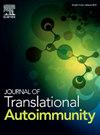Helicobacter mastomyrinus infection induces autoimmune hepatitis in mice
IF 3.6
Q2 IMMUNOLOGY
引用次数: 0
Abstract
Background
Autoimmune hepatitis (AIH) is a chronic progressive liver disease caused by the immune system mistakenly attacking its own hepatocytes. The role of the gut microbiome in the pathogenesis and progression of AIH is of considerable significance. However, the dearth of suitable animal models has significantly constrained advancements in the pathogenesis and the development of therapeutic strategies for AIH. Helicobacter mastomyrinus (H. mastomyrinus, Hm) is a potentially zoonotic pathogenic microorganism capable of causing diseases of the enterohepatic system in rodent laboratory animals. Nevertheless, research on its role and mechanisms in causing liver disease is severely limited.
Methods
In this study, male BALB/c mice were infected with Hm isolate Hm-17, and were sacrificed at 4 w, 8 w, 14 w and 22 w after infection, respectively. The serum was collected for detecting a number of AIH indicators, including the aminotransferases level, IgG content and autoantibody level. Additionally, the liver tissue was examined for pathological analysis, fibrosis, bacterial content, and the distribution of immune cells.
Results
It was observed that the infection initially caused focal necrotizing hepatitis and subsequently progressed to interface hepatitis with lymphocyte/plasma cell infiltration, as well as hypergammaglobulinemia and autoantibody reactions, predominantly to Anti-nuclear and anti-smooth muscle antibodies. Furthermore, as the infection persisted, the mice exhibited a progressive increase in liver fibrosis and mild steatosis. Despite the maintenance of a low level of Hm colonization in the liver, there was a notable infiltrate of macrophages, T and B lymphocytes. In particular, the inflammatory foci in the Hm-infected liver were highly enriched for IL17+ cells.
Conclusion
The present study provides an animal model of immunological liver injury induced by Hm infection that exhibits main characteristics similar to those observed in AIH-1 patients. This model may serve as a novel animal model for the study of the pathogenesis and potential therapeutic strategies for human AIH.
乳螺杆菌感染诱导小鼠自身免疫性肝炎
自身免疫性肝炎(AIH)是一种由免疫系统错误攻击自身肝细胞引起的慢性进行性肝病。肠道菌群在AIH发病和进展中的作用具有相当重要的意义。然而,缺乏合适的动物模型极大地限制了AIH发病机制和治疗策略的发展。乳齿幽门螺杆菌(h.m ostomyrinus, Hm)是一种潜在的人畜共患病原微生物,能够引起啮齿动物的肠肝系统疾病。然而,对其在肝脏疾病中的作用和机制的研究严重有限。方法用Hm分离株Hm-17感染BALB/c雄性小鼠,分别于感染后4、8、14、22 w处死。采集血清检测多种AIH指标,包括转氨酶水平、IgG含量和自身抗体水平。此外,对肝组织进行病理分析、纤维化、细菌含量和免疫细胞分布的检查。结果观察到感染最初引起局灶性坏死性肝炎,随后发展为伴有淋巴细胞/浆细胞浸润的界面性肝炎,并伴有高γ球蛋白血症和自身抗体反应,主要是抗核抗体和抗平滑肌抗体。此外,随着感染的持续,小鼠表现出肝纤维化和轻度脂肪变性的进行性增加。尽管Hm在肝脏中的定植维持在低水平,但巨噬细胞、T淋巴细胞和B淋巴细胞的浸润也很明显。特别是,感染hm的肝脏炎症灶高度富集IL17+细胞。结论本研究提供了一种与AIH-1相似的Hm感染引起的免疫性肝损伤动物模型。该模型可作为研究人类AIH发病机制和潜在治疗策略的一种新的动物模型。
本文章由计算机程序翻译,如有差异,请以英文原文为准。
求助全文
约1分钟内获得全文
求助全文
来源期刊

Journal of Translational Autoimmunity
Medicine-Immunology and Allergy
CiteScore
7.80
自引率
2.60%
发文量
33
审稿时长
55 days
 求助内容:
求助内容: 应助结果提醒方式:
应助结果提醒方式:


